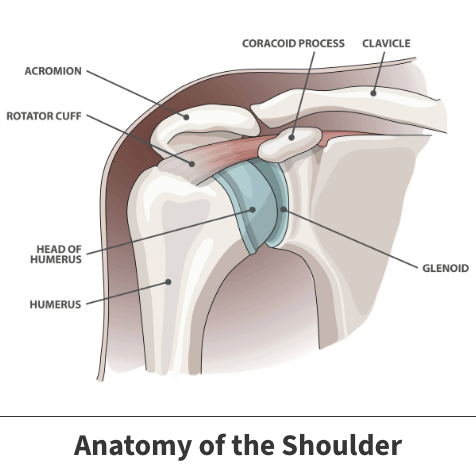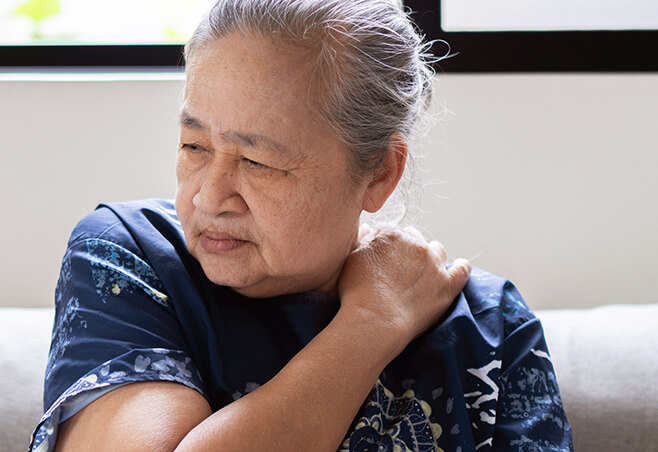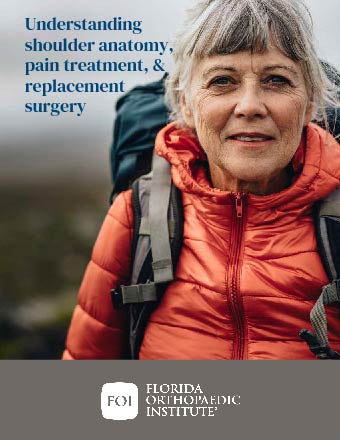Reverse total shoulder replacement
A reverse total shoulder replacement is an alternate procedure to a regular shoulder replacement. It was designed for people with large rotator cuff tears. It works the same as a regular shoulder replacement, but the joint is put in upside-down. The reason this alignment works better is that when the joint is put in reversed, different muscles are used to move the arm. If the rotator cuff (the muscle that allows for shoulder function) is badly torn and cannot be repaired, then different muscles are needed to move the arm. A reverse total shoulder replacement allows this to happen, while a standard shoulder replacement does not.
Anatomy

Your shoulder has three bones: your upper arm bone (humerus), shoulder blade (scapula), and collarbone (clavicle).
The head of the upper arm bone fits into a rounded socket (known as the glenoid) in your shoulder blade. A combination of muscles and tendons (the rotator cuff) keeps your arm bone centered in your shoulder socket. The rotator cuff covers the head of your upper arm bone and attaches it to the shoulder blade.
Within the shoulder joint, there are small, fluid-filled sacs known as bursae. They provide a cushion between your joints, which helps reduce friction between the muscles and bones in the joint.
About
A conventional or regular shoulder replacement utilize devices that mimic the normal anatomy of the shoulder. A plastic “cup” is fitted into the shoulder socket (glenoid), and a metal “ball” is attached to the top of the upper arm bone (humerus).
In a reverse total shoulder replacement, the socket and metal ball switch places. The metal ball is fixed to the socket, and the plastic cup is attached to the upper end of the humerus. This is why it is called reverse total shoulder replacement.
This type of procedure works better for people with cuff tear arthropathy (shoulder arthritis in the setting of a large rotator cuff tear) because it relies on different muscles to move the arm. In a healthy shoulder, the rotator cuff muscles help position and power the arm during the range of motion. In a patient with a large rotator cuff tear and cuff tear arthropathy, these muscles no longer function. The reverse total shoulder replacement relies on the deltoid muscle, instead of the rotator cuff, to power and position the arm.
Candidates for surgery
A reverse total shoulder replacement is typically recommended if you have any of the following conditions:
- A fully torn rotator cuff that cannot be repaired
- Cuff tear arthropathy
- A complex fracture of the shoulder joint
- A chronic shoulder dislocation
- A tumor of the shoulder joint
- A previous shoulder replacement that was unsuccessful
- Severe shoulder pain and difficulty moving your arm
- No success with other treatments

Treatment
In 1998, Dr. Frankle of Florida Orthopaedic Institute performed the first reverse shoulder replacement in the United States, here in Tampa. He developed the procedure to address patients with massive rotator cuff tears, providing the stability lost in these patients.
Surgical treatment
A reverse total shoulder replacement typically takes about two hours and begins with your surgeon making an incision to either the front or top of your shoulder. They then remove the damaged bone and position the new components to restore function to your shoulder. These components include a metal ball screwed into the shoulder socket and a plastic cup secured into the upper arm bone.
After surgery, your medical team will give you several doses of antibiotics to reduce your risk of infection and pain medication to keep you comfortable. Most patients can eat solid food and get out of bed the day after surgery. You will most likely be able to go home on the second or third day after surgery.
Recovery
After surgery, you will feel some pain and soreness. You will most likely be prescribed medications for short-term pain relief after surgery. Many types of medicines are available to help managing pain, as well as over-the-counter pain medications such as aspirin, Aleve (naproxen), and Advil/Motrin (ibuprofen).
Your doctor may use a combination of these medications to provide pain relief as well as minimize the need for opioids. While opioids do an excellent job of relieving pain, they are a narcotic and can be addictive. If you are prescribed opioids, stop taking them as soon as your pain begins to improve.
After you leave the hospital, your arm will need to be kept in a sling. The most important thing you can do to help your arm heal as quickly as possible is to keep any weight off of it and allow your arm to rest.
Your surgeon may instruct you to do gentle range of motion exercises to increase your mobility and endurance. A formal physical therapy program may also be recommended to strengthen your shoulder and improve flexibility.
You should be able to eat, dress, and groom yourself within a few weeks after surgery. Your surgeon may ask you to return for office visits and X-rays to check your shoulder.
World-class results
Florida Orthopaedic Institute’s shoulder surgeons have created one of the preeminent programs in the country. Dr. Mark Frankle, who was Fellowship trained at the Mayo Clinic, is one of the pioneers of Reverse Total Shoulder surgery.
Over the last 25 years, Dr. Frankle has performed thousands of total shoulder procedures, revolutionizing the procedures, the implants, and the results. His publications, lectures, courses, and books have won him international acclaim.
Together with Dr. Mark Mighell, Dr. Frankle runs the Shoulder and Elbow Fellowship, consisting of three Fellows mastering arthroscopic surgery of the shoulder, as well as fracture care and joint arthroplasty, with one of the largest volume reverse shoulder replacement programs in the country.
In the US, over 60% of total shoulder replacements are performed by surgeons who do approximately two replacements a year. The surgeons at Florida Orthopaedic Institute perform over 600 a year. High volume surgery means greater efficiencies, faster surgical times, and fewer complications. Because of these superior outcomes and cutting-edge research, Florida Orthopaedic Institute is dedicated to understanding diseases of the shoulder and producing world-class results.

Learn more about shoulder pain and procedures with our comprehensive guide.
Videos
Related specialties
- AC Joint Injuries
- Atraumatic Shoulder Instability
- Bankart Repair
- Bicep Tenodesis
- Broken Collarbone
- Bursitis of the Shoulder (Subacromial Bursitis)
- Calcific Tendinitis of the Shoulder
- Clavicle Fractures
- Dislocated Shoulder
- Fractures of the Shoulder Blade (Scapula)
- Glenoid Labrum Tear
- Impingement Syndrome of the Shoulder
- Little League Shoulder
- Rheumatoid Arthritis (RA) of the Shoulder
- Rotator Cuff Tears
- Shoulder Arthritis
- Shoulder Arthroscopy
- Shoulder Injury: Pain in the Overhead Athlete
- Shoulder Replacement
- Shoulder Separations
- Shoulder Socket Fracture (Glenoid Fracture)
- SLAP Tears & Repairs
- Subacromial Decompression
- Trapezius Strain (Muscle Strain Of The Upper Back)
- Traumatic Shoulder Instability
